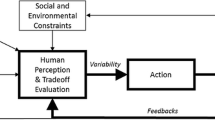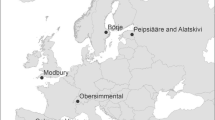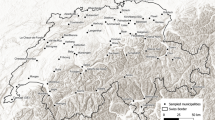Abstract
This study examines spatially referenced perceived landscape values and climate change risks collected through public participation geographic information systems for potential use in climate change planning. Using survey data from the Southern Fleurieu Peninsula, South Australia, we present a method for identifying perceived landscape values and climate change risks to describe and quantify their spatial associations. Two spatial data models—vector and raster—and two analytical methods—Jaccard coefficients and spatial cross-correlations were used to describe the spatial associations. Results indicate that perceptions of climate change risk are driven, in part, by the values people assign or hold for places on the landscape. Biodiversity and intrinsic landscape values have strong spatial association with biodiversity loss risk while recreation values have strong spatial association with riparian flooding, sea-level rise and wave action risks. Other landscape values show weak to no spatial association with perceived climate change risks. The methodology described in this research provides a mechanism for government agencies to develop place-based adaptation strategies based on these associations.
Similar content being viewed by others
References
Adger WN, Dessai S, Goulden M, Hulme M, Lorenzoni I, Nelson DR, Naess LO, Wolf J, Wreford A (2009) Are there social limits to adaptation to climate change? Clim Change 93:335–354
Altman IA, Low SM (eds) (1992) Place attachment. Plenum, New York
Australian Bureau of Statistics (2006) Census tables for the Fleurieu Statistical Subdivision. Australian Bureau of Statistics, Canberra. http://www.censusdata.abs.gov.au. Accessed 5 May 2008
Bardsley D (2006) There’s a change on the way—an initial integrated assessment of projected climate change impacts and adaptation options for natural resource management in the Adelaide and Mount Lofty Ranges region, DWLBC Report 2006/06, Government of South Australia, through Department of Water, Land and Biodiversity Conservation, Adelaide
Barkan SE (2004) Explaining public support for the environmental movement: a civic voluntarism model. Soc Sci Q 85:913–937
Bell A (1994) Climate of opinion: public and media discourse on the global environment. Discourse Soc 5(1):33–64
Beverly JL, Uto K, Wilkes J, Bothwell P (2008) Assessing spatial attributes of forest landscape values: an internet-based participatory mapping approach. Can J Forest Res 38:289–303
Black A, Liljeblad A (2006) Integrating social values in vegetation models via GIS: the missing link for the Bitterroot National Forest. Final report JFSP project no. 04-2-1-114, Missoula, MT, Aldo Leopold Wilderness Research Institute
Bord RJ, Fisher A, O’Connor R (1998) Public perceptions of global warming: United States and international perspectives. Climate Res 11:75–84
Bowen W (2002) An analytical review of environmental justice research: what do we really know? Environ Manage 29(1):3–15
Brody SD, Zahran S, Vedlitz A, Grover H (2008) Examining the relationship between physical vulnerability and public perceptions of global climate change in the United States. Environ Behav 40(1):72–95
Brooks N (2003) Vulnerability, risk and adaptation: a conceptual framework. Tyndall Centre working paper no. 38, Tyndall Centre for Climate Change Research, UK
Brown TC (1984) The concept of value in resource allocation. Land Econ 60:231–246
Brown G (2005) Mapping spatial attributes in survey research for natural resource management: methods and applications. Soc Natur Resour 18(1):17–39
Brown G (2006) Mapping landscape values and development preferences: a method for tourism and residential development planning. Int J Tourism Res 8(2):101–113
Brown G, Reed P (2000) Validation of a forest values typology for use in national forest planning. Forest Sci 46(2):240–247
Brown G, Reed P (2009) Public participation GIS: a new method for use in national forest planning. Forest Sci 55(2):166–182
Brown G, Smith C, Alessa L, Kliskey A (2004) A comparison of perceptions of biological value with scientific assessment of biological importance. Appl Geogr 24(2):161–180
Burns WJ, Slovic P, Kasperson RE, Kasperson JX, Renn O, Emani S (1993) Incorporating structural models into research on the social amplification of risk—implications for theory construction and decision-making. Risk Anal 13(6):611–623
City of Victor Harbor (2007) A community portrait of the City of Victor Harbor, Public Practice, Adelaide
Crichton D (1999) The risk triangle. In: Ingleton J (ed) Natural disaster management. Tudor Rose, London, pp 102–103
Cutter SL, Mitchell JT, Scott MS (2000) Revealing the vulnerability of people and places: a case study of Georgetown County, South Carolina. Ann Assoc Am Geogr 90(4):713–737
Davidson DJ, Williamson T, Parkins JR (2003) Understanding climate change risk and vulnerability in northern forest-based communities. Can J Forest Sci 33:2252–2261
DEH (2007) DCDB Parcel, Land Services Group. Department for Transport, Energy and Infrastructure, Adelaide
Dietz T (2001) Thinking about environmental conflict. In: Kadous L (ed) Celebrating scholarship. George Mason University, Fairfax, pp 31–54
Dietz T, Stern PC, Guagnano GA (1998) Social structural and social psychological bases for environmental concern. Environ Behav 30(4):450–471
Dillman D (1978) Mail and telephone surveys. Wiley, New York
Downing TE, Butterfield R, Cohen S, Huq S, Moss R, Rahman A, Sokona Y, Stephen L (2001) Vulnerability indices: climate change impacts and adaptation, UNEP Policy Series. UNEP, Nairobi
Etkin D, Ho E (2007) Climate change: perceptions and discourses of risk. J Risk Res 10(5):623–641
Fisher B, Turner RK, Morling P (2009) Defining and classifying ecosystem services for decision making. Ecol Econ 68:643–653
Fishwick L, Vining J (1992) Toward a phenomenology of recreation place. J Environ Psychol 12:57–63
Hill B, Duffield R (2002) Swamp management guidelines for the Fleurieu Peninsula. Conservation Council of South Australia, Adelaide
IPCC (2001) Climate change 2001: impacts, adaptation and vulnerability, summary for policymakers. WMO, Geneva
IPCC (2007) Climate change 2007: the physical science basis. Summary for policy makers. IPCC Working Group 1 Fourth Assessment Report. IPCC Secretariat, Geneva
Jorgensen BS, Stedman RC (2001) Sense of place as an attitude: lakeshore owners attitudes toward their properties. J Environ Psychol 21(3):233–248
Kaltenborn BP (1998) Effects of sense of place on responses to environmental impact: a case study among residents in an Arctic community. Appl Geogr 18(2):169–189
Kasperson RE, Kasperson JX (1996) The social amplification and attenuation of risk. Ann Am Acad Polit Soc Sci 545:95–105
Kasperson RE, Renn O, Slovic P, Brown HS, Emel J, Goble R, Kasperson JX, Ratick S (1988) The social amplification of risk: a conceptual framework. Risk Anal 8(2):177–187
Kelly PM, Adger WN (2000) Theory and practice in assessing vulnerability to climate change and facilitating adaptation. Climatic Change 47:325–352
Kellert SR (1996) The value of life: biological diversity and human society. Island Press, Washington, DC
Kempton W (1991) Lay perspectives on global climate change. Global Environ Change 1(3):183–208
Kliskey AD (1994) A comparative analysis of approaches to wilderness perception mapping. J Environ Manag 41:199–236
Kraus N, Malmfors T, Slovic P (2000) Intuitive toxicology: expert and lay judgements of chemical risks. In: Slovic P (ed) The perception of risk. Earthscan Publications, Virginia, pp 285–315
Kyle G, Graefe A, Manning R, Bacon J (2004) Effects of place attachment on users’ perceptions of social and environmental conditions in a natural setting. J Environ Psychol 24:213–225
Leiserowitz A (2006) Climate change risk perception and policy preferences: the role of affect, imagery and values. Climatic Change 77:45–72
Leroux SJ, Schmiegelow FKA, Nagy JA (2007) Potential spatial overlap of heritage sites and protected areas in a Boreal Region of Northern Canada. Conserv Biol 21(2):376–386
Lockwood M (1999) Humans valuing nature: synthesising insights from philosophy, psychology and economics. Environ Val 8:381–401
McDaniels T, Axelrod LJ, Slovic P (1995) Characterizing perception of ecological risk. Risk Anal 15(5):575–588
McFarlane BL (2005) Public perceptions of risk to forest biodiversity. Risk Anal 25(3):543–553
McInnes KL, Suppiah R, Whetton H, Hennessy KJ, Jones RN (2003) Climate change in South Australia. CSIRO Atmospheric Research, Melbourne
McIntyre N, Moore J, Yuan M (2008) A place-based, values-centered approach to managing recreation on Canadian crown lands. Soc Nat Resour 21(8):657–670
Myers R (1990) Classical and modern regression with applications. Duxbury, Boston, MA
Norris FH, Friedman MJ, Watson PJ, Byrne CM, Diaz E, Kaniasty K (2002) 60,000 disaster victims speak: part 1. An empirical review of the empirical literature, 1981–2001. Psychiatry 65(3):207–239
O’Connor RE, Bord RJ, Yarnal B, Wiefek N (2002) Who wants to reduce greenhouse gas emissions? Soc Sci Q 83:1–17
Parry ML, Canziani OF, Palutikof JP et al (2007) Technical summary. Climate change 2007: impacts, adaptation and vulnerability. Contribution of working group II to the fourth assessment report of the intergovernmental panel on climate change. In: Parry ML, Canziani OF, Palutikof JP, van der Linden PL, Hanson CE (eds). Cambridge University Press, Cambridge, pp 23–78
Pfueller S, Zhu X, Whitelaw P, Winter C (2008) Community values for Murray river forest reserves in Victoria. Sustainable Tourism CRC, Queensland
Raymond C (2008) Mapping landscape values and perceived climate change risks for natural resources management: a study of the Southern Fleurieu Peninsula region, DWLBC Report 2008/07, Government of South Australia, through Department of Water, Land and Biodiversity Conservation, Adelaide
Raymond C, Brown G (2006) A method for assessing protected area allocations using a typology of landscape values. J Environ Plann Manag 49(6):797–812
Relph E (1976) Place and placelessness. Pion Limited, London
Renn O, Burns WJ, Kasperson JX (1992) The social amplification of risk—theoretical foundations and empirical applications. J Soc Issues 48(4):137–160
Rokeach M (1973) The nature of human values. Free Press, New York
Rolston H, Coufal J (1991) A forest ethic and multivalue forest management. J Forest 80(4):35–40
Satterfield TA, Mertz CK, Slovic P (2004) Discrimination, vulnerability and justice in the face of risk. Risk Anal 24(1):115–129
Savage I (1993) Demographic influences on risk perceptions. Risk Anal 13(4):413–420
Schwartz SH (1992) Universals in the content and structure of values: theory and empirical tests in 20 countries. In: Zanna M (ed) Advances in experimental social psychology, vol 25. Academic Press, New York, pp 1–65
Schwartz SH (1994) Are there universal aspects in the content and structure of values? J Soc Issues 50:19–45
Sieber R (2006) Public participation and geographic information systems: a literature review and framework. Ann Am Assoc Geogr 96(3):491–507
Slimak MW, Dietz T (2006) Personal values, beliefs and ecological risk perception. Risk Anal 26(6):1689–1705
Slovic P (2000) Do adolescent smokers know the risks? In: Slovic P (ed) The perception of risk. Earthscan Publications, Virginia, pp 364–371
Slovic P (2001) Perceptions of risk. Earthspan, London
Slovic P, Fischhoff B, Lichtenstein S (1982) Why study risk perception? Risk Anal 2(2):83–93
Smit B, Pilifosova O, Burton I, Challenger B, Huq S, Klein RJT, Yuoge G (2001) Adaptation to climate change in the context of sustainable development and equity. In: McCarthy JJ, Canziani OF, Leary NA, Dokken DJ, White KS (eds) Climate change 2001: impacts, adaptation and vulnerability. Contribution of working group II to the third assessment report of the intergovernmental panel on climate change. Cambridge University Press, Cambridge, pp 877–912
Stedman R (2003a) Is it really just a social construction? The contribution of the physical environment to sense of place. Soc Nat Resour 16:671–685
Stedman R (2003b) Sense of place and forest science: toward a program of quantitative research. Forest Sci 49(6):822–829
Stedman RC (2004) Risk and climate change: perceptions of key policy actors in Canada. Risk Anal 24(5):1395–1406
Stern PC (2000) Toward a coherent theory of environmentally significant behaviour. J Soc Issues 56(3):407–424
Stern PC, Dietz T, Kalof L (1993) Value orientations, gender, and environmental concern. Environ Behav 25:322–348
Suppiah R, Preston B, Whetton PH, McInnes KL, Jones RN, Macadam I, Bathols J, Kirono D (2006) Climate change under enhanced greenhouse conditions in SA. Climate Impacts and Risk Group, CSIRO Marine and Atmospheric Research, Melbourne
Thomas DSG, Twyman C (2005) Equity and justice in climate change adaptation amongst natural-resource-dependent societies. Global Environ Change 15:115–124
Tyrväinnen L, Mäkinen K, Schipperijn J (2007) Tools for mapping social values of urban woodlands and other green areas. Landsc Urban Plan 79(1):5–19
UNDHA (1992) Internationally agreed glossary of basic terms related to disaster management. United Nations Department of Humanitarian Affairs, Geneva
Urban and Regional Planning Solutions (2007) Fleurieu Peninsula region integrated strategic tourism plan 2007–2012. Urban and Regional Planning Solutions, Adelaide
van Jaarsveld AS, Freitag S, Chown SL, Muller C, Koch S, Hull H, Bellamy C, Krüger M, Endrödy-Younga S, Mansell MW, Scholtz CH (1998) Biodiversity assessment and conservation strategies. Science 279:2106–2108
Vorkinn M, Riese H (2001) Environmental concern in a local context: the significance of place attachment. Environ Behav 33(2):249–263
Worton BJ (1987) A review of models of home range for animal movement. Ecol Model 38:277–298
Yohe GW, Lasco RD, Ahmad QK, Arnell NW, Cohen SJ, Hope C, Janetos AC, Perez RT (2007) Perspectives on climate change and sustainability. In: Parry ML, Canziani OF, Palutikof JP, van der Linden PJ, Hanson CE (eds) Climate change 2007: impacts, adaptation and vulnerability. Contribution of working group II to the fourth assessment report of the intergovernmental panel on climate change. Cambridge University Press, Cambridge, pp 811–841
Zelezny L, Poh-Pheng Chua C, Aldrich C (2000) Elaborating on gender differences in environmentalism. J Soc Issues 56:443–457
Zube EH (1987) Perceived land use patterns and landscape values. Landsc Ecol 1(1):37–45
Author information
Authors and Affiliations
Corresponding author
Rights and permissions
About this article
Cite this article
Raymond, C.M., Brown, G. Assessing spatial associations between perceptions of landscape value and climate change risk for use in climate change planning. Climatic Change 104, 653–678 (2011). https://doi.org/10.1007/s10584-010-9806-9
Received:
Accepted:
Published:
Issue Date:
DOI: https://doi.org/10.1007/s10584-010-9806-9




